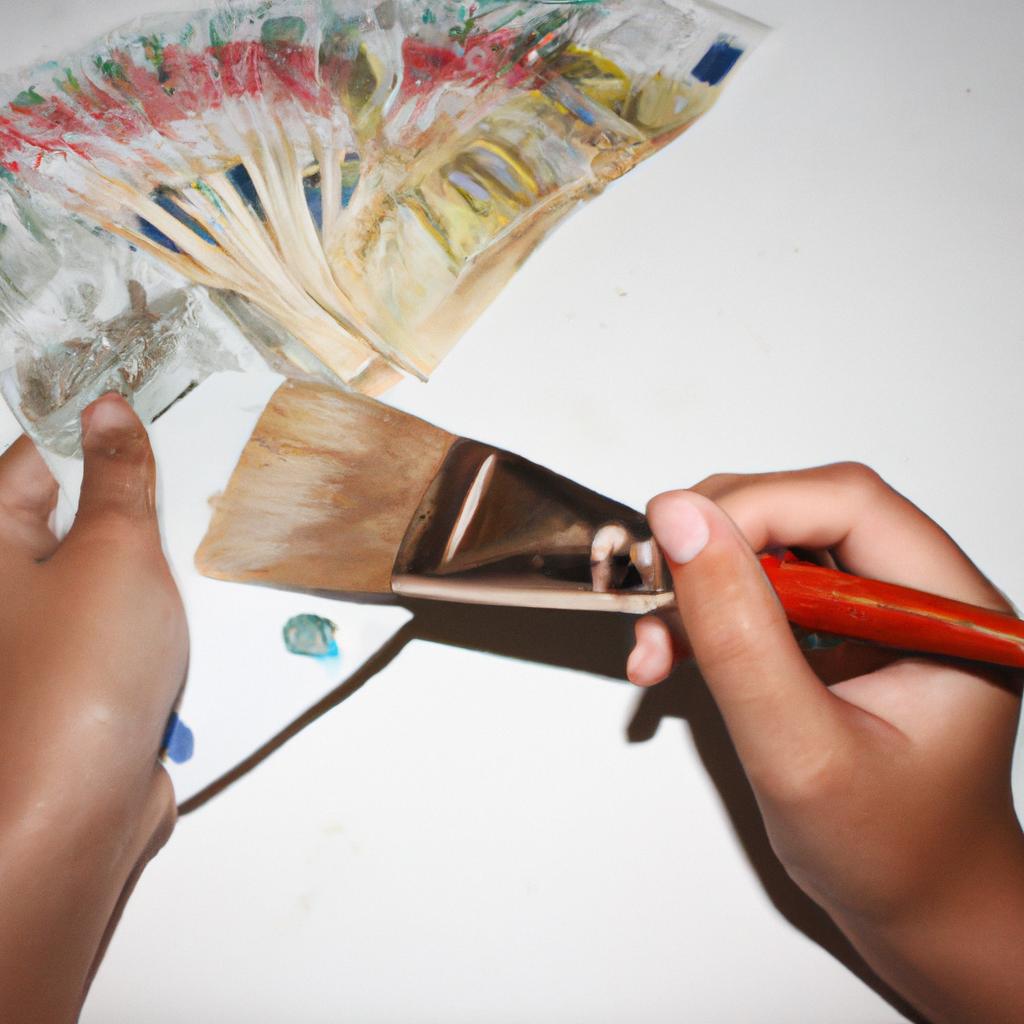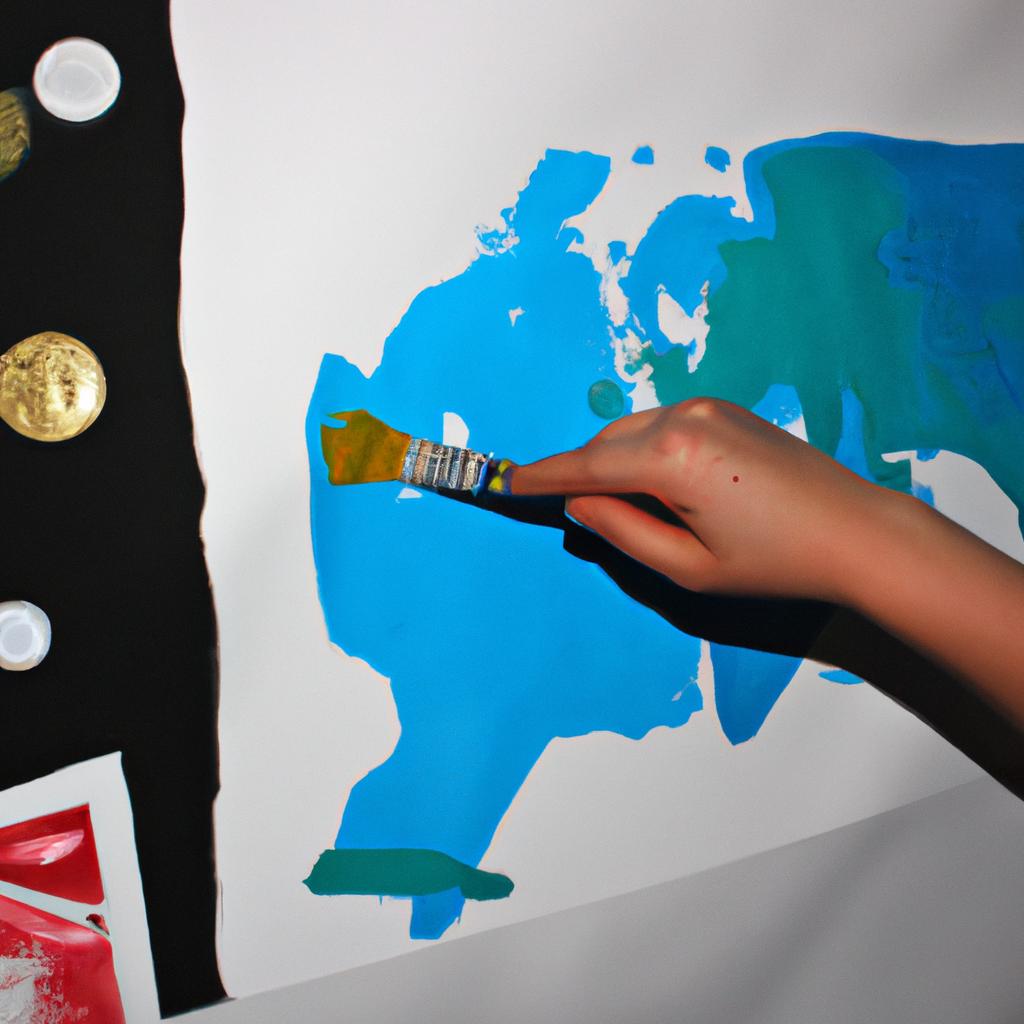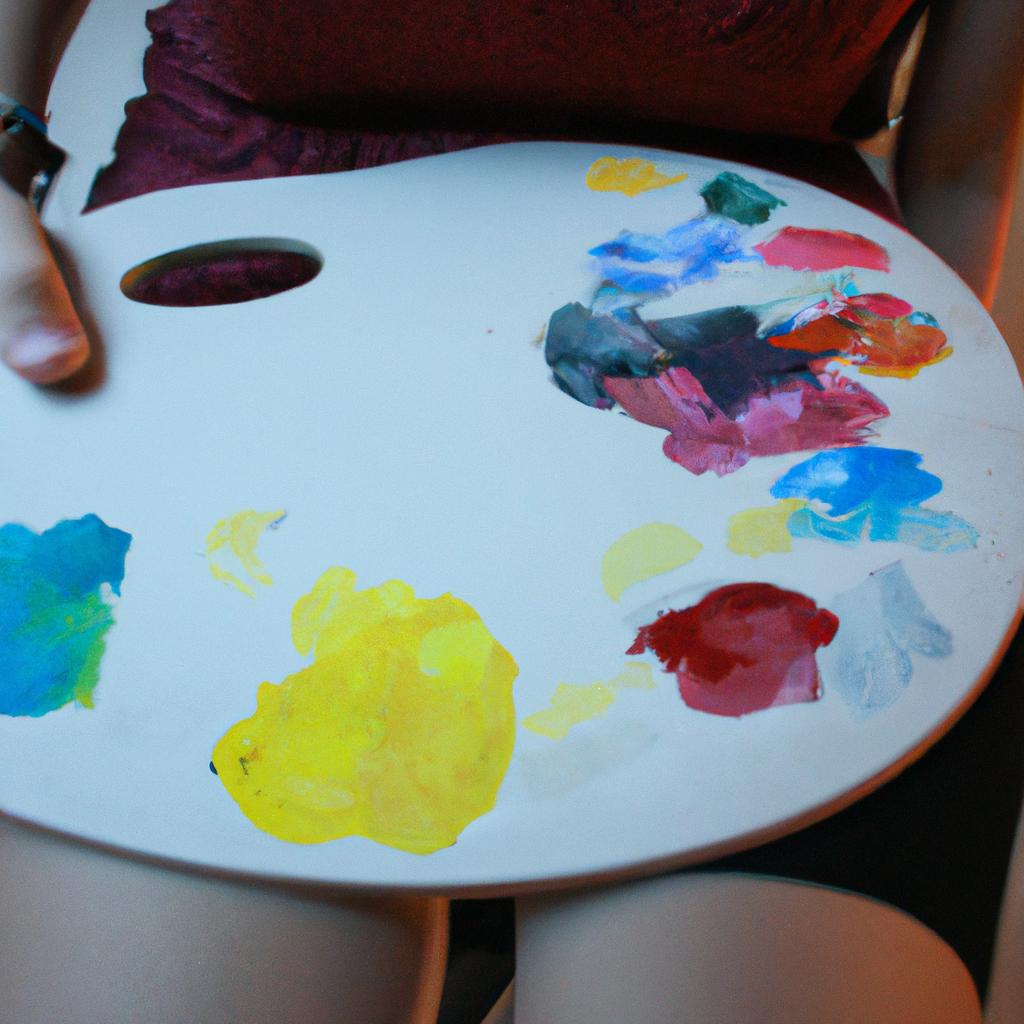The rapid advancement of technology has revolutionized the way artists and illustrators can promote and sell their artwork. In an era where online platforms have become prominent marketplaces, artists now have the opportunity to reach a global audience from the comfort of their own studio. For instance, consider the case of Sarah, a talented illustrator who struggled to gain recognition for her work in local galleries. However, after taking her art online, she experienced a surge in sales and received commissions from clients across different continents.
This article aims to provide creative financial tips specifically tailored to artists and illustrators looking to sell their artwork online. By exploring various strategies and techniques, this piece seeks to empower artists with practical knowledge that can help them maximize profits while navigating the intricate world of e-commerce. From setting competitive prices to building a strong brand presence on social media platforms, these insights will equip artists with valuable tools necessary for success in selling their artwork online. Whether you are an emerging artist seeking your first sale or an established illustrator aiming to expand your market reach, this article is designed to offer guidance and support throughout your artistic journey in the digital realm.
Setting realistic pricing for your artwork
Setting realistic pricing for your artwork is a crucial step in successfully selling your creations online. It not only helps you to attract potential buyers but also ensures that you receive fair compensation for your talent and effort. To determine the right price, it’s important to consider factors such as materials used, time invested, market demand, and comparable works by other artists.
For example, let’s imagine an artist named Sarah who specializes in acrylic paintings. She spends several hours creating a vibrant landscape piece using high-quality paints and canvas. To set a realistic price, Sarah should take into account the cost of her materials, including brushes and varnishes. Additionally, she needs to factor in the time spent on research, sketching, painting layers, and finishing touches. By considering these elements, Sarah can arrive at a pricing structure that reflects both her artistic skill and the value of her artwork.
To further guide artists like Sarah in setting their prices effectively, here are some essential considerations:
- Assessing market trends: Research current art market trends specific to your style or genre to understand what collectors are interested in buying.
- Evaluating similar artworks: Examine the prices of comparable pieces created by fellow artists with similar experience levels and styles.
- Balancing supply and demand: Adjust your pricing strategy based on how many similar artworks are available versus the level of interest from potential buyers.
- Factoring in reputation: If you have established yourself as an accomplished artist with a strong following or recognition within the industry, you may be able to command higher prices.
By integrating these guidelines into your pricing decisions, you will increase your chances of attracting customers who appreciate your work while ensuring that you receive appropriate financial compensation.
Moving forward onto showcasing your artwork through social media platforms
Utilizing social media platforms to showcase your artwork
Once you have set realistic pricing for your artwork, it is time to focus on showcasing it effectively. Social media platforms provide artists and illustrators with an excellent opportunity to reach a wider audience and gain recognition in the art community. By utilizing these platforms strategically, you can enhance your online presence and attract potential buyers.
Case Study:
To illustrate the impact of utilizing social media platforms, let’s consider the example of Sarah, an emerging artist who primarily works with watercolors. Initially, she had limited exposure for her artwork as she relied solely on local exhibitions and word-of-mouth referrals. However, after actively promoting her work on Instagram and Facebook, Sarah experienced a significant increase in visibility and engagement with her target audience. This ultimately led to increased sales opportunities and collaborations with other artists.
Benefits of using social media platforms for showcasing artwork:
- Expanded reach: Social media allows you to connect with individuals worldwide who share similar artistic interests.
- Increased engagement: Through likes, comments, and shares, you can receive valuable feedback that helps improve your craft.
- Networking opportunities: Building connections within the art community can lead to collaborative projects or gallery exhibitions.
- Enhanced brand image: Consistently sharing high-quality images of your artwork establishes a professional online presence.
| Platforms | Pros | Cons |
|---|---|---|
| Visual-focused | Algorithm changes | |
| Wide user base | Decline in organic reach | |
| Excellent for inspiration | Less interactive platform |
By leveraging social media platforms effectively, artists like Sarah can significantly amplify their online presence and broaden their potential buyer base. These platforms not only serve as virtual galleries but also facilitate networking opportunities within the art community. In our next section about building an online portfolio to attract potential buyers, we will delve further into the strategies for creating a compelling online presence.
Now, let’s explore how building an online portfolio can help you attract potential buyers and showcase your artwork in a more professional manner.
Building an online portfolio to attract potential buyers
Utilizing social media platforms to showcase your artwork has become an essential strategy for artists and illustrators in today’s digital age. However, it is equally important to build a professional online portfolio that can attract potential buyers and establish your credibility as an artist. By creating a well-designed and user-friendly website or using dedicated portfolio platforms, you can effectively showcase your work and increase the chances of securing sales.
One example of how building an online portfolio can benefit artists is illustrated through the success story of Emily, a freelance illustrator. Emily decided to create her own website where she could display her artwork in different categories such as illustrations for children’s books, editorial designs, and character sketches. By organizing her work into separate sections on her website, she was able to cater to specific target audiences, making it easier for potential buyers to navigate through her portfolio.
When developing your online portfolio, consider incorporating the following elements:
- High-resolution images: Ensure that the images of your artwork are clear and visually appealing.
- Artist statement: Include a brief description about yourself as an artist and what inspires your creations.
- Contact information: Make it easy for interested buyers to reach out to you by providing contact details on each page of your portfolio.
- Testimonials: If you have received positive feedback or testimonials from previous clients or customers, include them on your website to build trust with potential buyers.
Creating a captivating online portfolio not only showcases your talent but also helps establish a strong brand identity for yourself as an artist. It allows potential buyers to get a glimpse into your creative world and make informed decisions when purchasing art.
Transitioning into the subsequent section about “Offering limited edition prints or merchandise to increase revenue,” artists can further enhance their financial prospects by exploring additional avenues beyond original artwork sales.
Offering limited edition prints or merchandise to increase revenue
Building an impressive online portfolio can greatly attract potential buyers to your artwork. Once you have established a strong platform, it is time to explore additional strategies that will help maximize your revenue and expand your reach. One effective method is offering limited edition prints or merchandise, which not only increases your sales but also provides collectors with unique pieces of art.
Limited edition prints are reproductions of your original artwork in a set quantity, often signed and numbered by the artist. By creating exclusivity through limited availability, you can generate a sense of urgency among buyers who don’t want to miss out on owning a special piece from their favorite artist. For instance, let’s consider the case study of an illustrator named Sarah who decided to release 50 limited edition prints of her popular digital painting series. The demand was so high that all the prints were sold within two weeks, generating substantial profits for Sarah while allowing her fans to own something truly exceptional.
To effectively offer limited edition prints or merchandise, here are some key points to consider:
- Set a reasonable price point that reflects the value and exclusivity of the limited edition items.
- Clearly communicate the scarcity and uniqueness of these products through engaging descriptions and marketing materials.
- Use social media platforms or email newsletters to create buzz around the release date and build anticipation among your audience.
- Provide incentives such as early access or discounts for loyal customers who have supported your work before.
| Benefits of Offering Limited Edition Prints |
|---|
| 1. Exclusivity and rarity |
| 2. Increased perceived value |
| 3. Potential for higher profit margins |
| 4. Enhanced collector appeal |
By incorporating these elements into your selling strategy, you can tap into a market segment that values collectible artworks and increase both immediate sales and long-term brand loyalty.
Collaborating with other artists or influencers for cross-promotion is another effective approach towards expanding your audience base and boosting online sales. By teaming up with like-minded creatives, you can leverage each other’s platforms and reach a wider audience that may not have been aware of your work.
Collaborating with other artists or influencers for cross-promotion
Boosting Visibility through Social Media Marketing
In addition to offering limited edition prints or merchandise, collaborating with other artists or influencers can be a powerful strategy for increasing your artwork’s visibility and reaching new audiences. By teaming up with like-minded individuals who have a strong presence on social media platforms, you can leverage their following to expand your own reach.
For example, imagine an artist named Sarah who specializes in creating intricate watercolor portraits. She decides to collaborate with another popular artist, Lisa, who is known for her vibrant digital illustrations. Together, they create a series of joint artworks that blend both of their unique styles. They promote this collaboration across their respective social media accounts and encourage their followers to check out each other’s work.
To effectively collaborate with others and maximize the impact of cross-promotion, consider the following tips:
- Find compatible partners: Look for artists or influencers whose style complements yours or aligns with your target audience.
- Define clear goals: Clearly communicate what you hope to achieve from the collaboration and establish mutual expectations.
- Create compelling content: Develop visually appealing collaborative pieces that capture the attention of both your audiences.
- Leverage social media channels: Promote the partnership extensively on various social media platforms to generate buzz.
| Pros | Cons | Tips |
|---|---|---|
| Increased exposure | Potential conflicts | Communicate openly about expectations |
| Access to new audiences | Differences in working methods | Establish common ground before starting |
| Enhanced credibility | Sharing revenue/profit concerns | Discuss financial arrangements beforehand |
| Collaboration opportunities | Misalignment in brand values | Ensure shared vision and mission |
Collaborating with other artists or influencers allows for creative exchange and potential growth within your artistic community. It presents an opportunity for increased exposure, access to new audiences, enhanced credibility, and future collaboration prospects.
Transitioning into the subsequent section, “Researching and utilizing effective keywords for SEO optimization,” artists and illustrators can further enhance their online presence by optimizing their digital content with relevant keywords. By understanding how to effectively employ SEO strategies, you can ensure that your artwork reaches a wider audience on various platforms.
Researching and utilizing effective keywords for SEO optimization
Transition from previous section:
Building on the idea of cross-promotion, another crucial aspect to consider when selling artwork online is researching and utilizing effective keywords for SEO optimization.
Section: Researching and Utilizing Effective Keywords for SEO Optimization
To ensure maximum visibility and reach for your artwork, it is essential to understand how search engine optimization (SEO) works. By incorporating relevant keywords into your online listings and descriptions, you can improve your chances of being discovered by potential buyers. Let’s consider an example:
Imagine you are a digital illustrator specializing in fantasy landscapes. To attract more customers searching for this type of artwork, you need to identify the most appropriate keywords that accurately describe your style and subject matter. Some potential keywords could include “fantasy art,” “digital illustrations,” “landscapes,” and “magical worlds.” By strategically placing these keywords within your website content or product descriptions, you increase the likelihood of appearing higher in organic search results.
Effective keyword research involves understanding not only what words your target audience might use but also which ones have low competition yet high search volume. This combination allows you to optimize your content effectively while maximizing exposure. Here are some tips to help you with your keyword research process:
- Use keyword research tools like Google Keyword Planner or SEMrush.
- Analyze competitor websites and note the keywords they prioritize.
- Look for long-tail keywords that are specific to your niche.
- Regularly monitor keyword trends and adjust accordingly.
By employing these strategies, you can enhance the discoverability of your artwork and increase traffic to your online platforms.
| Benefits of Keyword Optimization | Examples |
|---|---|
| Higher rankings in search results | Increased visibility leads to more clicks |
| Enhanced targeting of specific audiences | Connect with individuals interested in similar styles/themes |
| Improved conversion rates | Attract qualified leads likely to make purchases |
Through diligent keyword research and implementation, artists can greatly improve their online presence, ensuring their artwork reaches the right audience. By understanding how SEO optimization can positively impact visibility and sales, artists can effectively promote their creations to a wider customer base.
Remember, attracting customers through search engines is just one part of your overall marketing strategy.
 PSP Oste
PSP Oste



